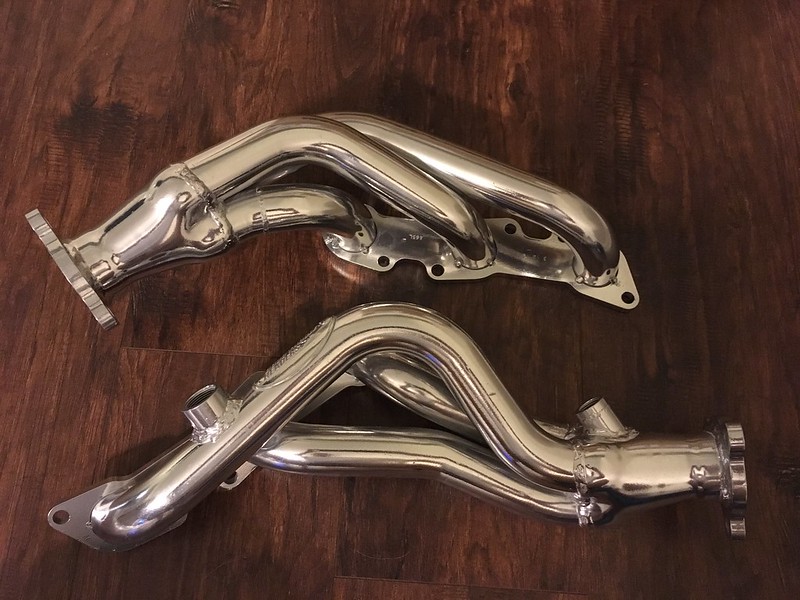[url=https://flic.kr/p/PL2dqK] [/url]
[/url]
 [/url]
[/url]  [/url]
[/url] I wouldn't wish that boat anchor on any Nissan. Yes they can make power, but horrible to work on and a whole lot of iron.MouthBQ98 said:
Unforutnately, a VG30DETT doesn't fit in the engine bay of an Xterra that I know of.
TSJ said:
Much better off w/ LS swap
 to the last part.
to the last part. silverado_lover said:
Y'all got anymore of them LS swaps?

MouthBQ98 said:
is a true 2.25" all the way through instead of 2", so I get a little more flow without dropping the back pressure too much.

MouthBQ98 said:
back pressure

I am puzzled....MouthBQ98 said:
Heh, I've got to stop reading car sites heavily populated with rednecks. Apparently the issue is exhaust Velocity, and as your exhaust Has no variable diameter, you have to pick the size exhaust system to optimize either torque with lower velocity or power with higher velocity, in simplistic terms. So I probably did good not upsizing much as I am more focused on torque.
MouthBQ98 said:
Your optimal velocity will change as you alter the restrictiveness of the system, changing the rpm range where you get the most power or torque. I want more torque at a lower rpm so I will want my velocity max to be reached sooner.

Quote:
We've seen quiet a few "experienced" racers tell people that a bigger exhaust is a better exhaust. Hahaha NOT.
As discussed earlier, exhaust gas is hot. And we'd like to keep it hot throughout the exhaust system. Why? The answer is simple. Cold air is dense air, and dense air is heavy air. We don't want our engine to be pushing a heavy mass of exhaust gas out of the tailpipe. An extremely large exhaust pipe will cause a slow exhaust flow, which will in turn give the gas plenty of time to cool off en route. Overlarge piping will also allow our exhaust pulses to achieve a higher level of entropy, which will take all of our header tuning and throw it out the window, as pulses will not have the same tendency to line up as they would in a smaller pipe. Coating the entire exhaust system with an insulative material, such as header wrap or a ceramic thermal barrier coating reduces this effect somewhat, but unless you have lots of cash burning a hole in your pocket, is probably not worth the expense on a street driven car.
Quote:
To gain a more complete understanding of how mufflers and headers do their job, we must be familiar with the dynamics of the exhaust pulse itself. Exhaust gas does not come out of the engine in one continuous stream. Since exhaust valves open and close, exhaust gas will flow, then stop, and then flow again as the exhaust valve opens. The more cylinders you have, the closer together these pulses run.
Keep in mind that for a "pulse" to move, the leading edge must be of a higher pressure than the surrounding atmosphere. The "body" of a pulse is very close to ambient pressure, and the tail end of the pulse is lower than ambient. It is so low, in fact, that it is almost a complete vacuum! The pressure differential is what keeps a pulse moving. A good Mr. Wizard experiment to illustrate this is a coffee can with the metal ends cut out and replaced with the plastic lids. Cut a hole in one of the lids, point it toward a lit candle and thump on the other plastic lid. What happens? The candle flame jumps, then blows out! The "jump" is caused by the high-pressure bow of the pulse we just created, and the candle goes out because the trailing portion of the pulse doesn't have enough oxygen-containing air to support combustion. Neat, huh?
Ok, now that we know that exhaust gas is actually a series of pulses, we can use this knowledge to propagate the forward-motion to the tailpipe. How? Ah, more of the engineering tricks we are so fond of come in to play here.
Just as Paula Abdul will tell you that opposites attract, the low pressure tail end of an exhaust pulse will most definitely attract the high-pressure bow of the following pulse, effectively "sucking" it along. This is what's so cool about a header. The runners on a header are specifically tuned to allow our exhaust pulses to "line up" and "suck" each other along! Whoa, bet you didn't know that! This brings up a few more issues, since engines rev at various speeds, the exhaust pulses don't always exactly line up. Thus, the reason for the Try-Y header, a 4-into-1 header, etc. Most Honda headers are tuned to make the most horsepower in high RPM ranges; usually 4,500 to 6,500 RPM. A good 4-into-1 header, such as the ones sold by Gude, are optimal for that high winding horsepower you've always dreamed of. What are exhaust manifolds and stock exhaust systems good for? Besides a really cheap boat anchor? If you think about it, you'll realize that since stock exhausts are so good at restricting that they'll actually ram the exhaust pulses together and actually make pretty darn good low-end torque! Something to keep in mind, though, is that even though an OEM exhaust may make gobs of low-end torque, they are not the most efficient setup overall, since your engine has to work so hard to expel those exhaust gasses. Also, a header does a pretty good job of additionally "sucking" more exhaust from your combustion chamber, so on the next intake stroke there's lots more fresh air to burn. Think of it this way: At 8,000 RPM, your Integra GS-R is making 280 pulses per second. There's a lot more to be gained by minimizing pumping losses as this busy time than optimizing torque production during the slow season.
Vid?MouthBQ98 said:
Cat back Gibson exhaust is on, the replacement intermediate pipes, new studs and bolts, seals and gaskets, and flowmaster cats to replace the factory cats that "suddenly rusted out" arrive tomorrow.